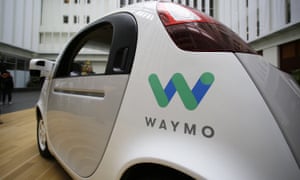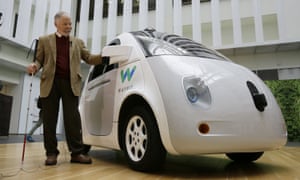Google spins off self-driving car division, signalling new direction
Google spins off self-driving car division, signalling new direction
Standalone unit Waymo will have more power to set its own priorities, but move comes after key employees walked away
Google’s self-driving cars have graduated from the company’s “moonshot division”, X labs, to become a full-blown subsidiary of umbrella group Alphabet, called Waymo.
The new company, headed by X alumni John Krafcik, is charged with turning the self-driving car technology that Google has been developing behind closed doors into a viable business for the future.
How that will actually happen, though, Waymo has apparently not yet decided. Mooted revenue streams include Uber-style driverless ride sharing, disrupting the trucking and logistics sector, fitting self-driving technology into public transit vehicles, improving the “last mile” of postal delivery or even simply licensing the software to car manufacturers who will sell cars to end users.
“Self-driving technology is awesome in all these categories,” said Krafcik at an event to announce the launch of Waymo. But one thing Waymo won’t be doing is building its own cars – a step back in ambition from the highest goals of the X labs team.
“We are a self-driving technology company,” Krafcik said. “We’ve been really clear that we’re not a car company, although there’s been some confusion on that point. We’re not in the business of making better cars. We’re in the business of making better drivers.”
That means the small, purpose-built “Koala cars” that Google currently uses for testing its self-driving technology are unlikely to evolve into an actual product that consumers can buy. Instead, the best hope for someone who wants to get their hands on Google’s software looks to be Fiat Chrysler, who signed a deal with Google in May to put its self-driving tech in a small fleet of the company’s Pacifica minivans. If that deal expands into a full-blown partnership, Fiat Chrysler could be the first company selling Google tech to end users.
If not Fiat Chrysler, Waymo will have to pair with someone, because Google is fast becoming a victim of its own success. When the company first initiated its self-driving product at X Labs, it was almost alone in Silicon Valley in thinking that self-driving cars were a solvable problem. But as the years progressed, others joined the field, some directly inspired by Google’s success: Uber’s Travis Kalanick has spoken about how he was inspired to enter the self-driving car business by a ride in one of Google’s prototypes. He promptly hired a substantial portion of Carnegie-Mellon university’s ground-breaking robotics lab.
Conventional auto manufacturers have also entered the fray: as well as Tesla Motors, whose Autopilot system is one of the most advanced driver-assist features on the market, older businesses like Ford, BMW and Nissan have all pushed their own automation systems onto the market.
Part of the reason for Google losing its lead in the market was the company’s insistence on only pursuing full automation. “The system we have built is aimed at full autonomy, and it is therefore much more complicated than a lot of these other systems,” X labs engineer Andrew Chatham told the Guardian in August. “This is not the engineeringly efficient or cost-effective way to build something that just helps you stay in your lane.”
It is unclear whether Waymo will continue that all-or-nothing goal. Google proudly trumpeted a previously secret milestone it had achieved in the summer of 2015, when a blind man, Steve Mahan, had “driven”, unaccompanied, one of its Koala cars on the public roads of Austin, Texas. That trip was the world’s first fully driverless trip on public roads.
But behind the scenes, reports suggest that Waymo might pull the trigger
on the technology earlier than the company intended to when it was
simply a research lab. On Monday, industry news site The Information reported
the groundbreaking partnership with Fiat Chrysler had represented one
step towards that intermediary goal, to the concern of some of Google’s
self-driving engineers.
Some of those engineers have left the company since the new direction was decided at the start of 2016. Chris Urmson, the former head of the division, quit this summer to start a new company, less than a year after Krafcik was hired. Anthony Levandowski, one of the industry’s pioneers, left in early 2016 to found a self-driving truck startup, Otto, which has since been acquired by Uber. Jiajun Zhu, a founder member of the team, and software engineering manager Dave Ferguson left in the summer to co-found autonomous car company Nuro. In total, 14 members of the team are known to have left in 2016 alone.
As a fully standalone unit, Waymo will have more power within the wider Alphabet hierarchy to set its priorities and decide its own future. But that power also comes with responsibility: for the first time, Google’s self-driving cars will have a bottom line, and an expectation that, at some point, it will start paying its own way. Simply making the best technology isn’t the only requirement to making money in the car industry – Waymo also needs to make friends.
Leave some comments...
Posted By Abayomi Ismail
source: https://www.theguardian.com
 |
| Waymo is charged with turning the self-driving car technology that Google has been developing into a viable business for the future. Photograph: Eric Risberg/AP |
Google’s self-driving cars have graduated from the company’s “moonshot division”, X labs, to become a full-blown subsidiary of umbrella group Alphabet, called Waymo.
The new company, headed by X alumni John Krafcik, is charged with turning the self-driving car technology that Google has been developing behind closed doors into a viable business for the future.
How that will actually happen, though, Waymo has apparently not yet decided. Mooted revenue streams include Uber-style driverless ride sharing, disrupting the trucking and logistics sector, fitting self-driving technology into public transit vehicles, improving the “last mile” of postal delivery or even simply licensing the software to car manufacturers who will sell cars to end users.
“Self-driving technology is awesome in all these categories,” said Krafcik at an event to announce the launch of Waymo. But one thing Waymo won’t be doing is building its own cars – a step back in ambition from the highest goals of the X labs team.
“We are a self-driving technology company,” Krafcik said. “We’ve been really clear that we’re not a car company, although there’s been some confusion on that point. We’re not in the business of making better cars. We’re in the business of making better drivers.”
 |
| The small, purpose-built ‘Koala cars’ that Google currently uses for testing its self-driving technology are unlikely to evolve into an actual product that consumers can buy. Photograph: Eric Risberg/AP |
That means the small, purpose-built “Koala cars” that Google currently uses for testing its self-driving technology are unlikely to evolve into an actual product that consumers can buy. Instead, the best hope for someone who wants to get their hands on Google’s software looks to be Fiat Chrysler, who signed a deal with Google in May to put its self-driving tech in a small fleet of the company’s Pacifica minivans. If that deal expands into a full-blown partnership, Fiat Chrysler could be the first company selling Google tech to end users.
If not Fiat Chrysler, Waymo will have to pair with someone, because Google is fast becoming a victim of its own success. When the company first initiated its self-driving product at X Labs, it was almost alone in Silicon Valley in thinking that self-driving cars were a solvable problem. But as the years progressed, others joined the field, some directly inspired by Google’s success: Uber’s Travis Kalanick has spoken about how he was inspired to enter the self-driving car business by a ride in one of Google’s prototypes. He promptly hired a substantial portion of Carnegie-Mellon university’s ground-breaking robotics lab.
Conventional auto manufacturers have also entered the fray: as well as Tesla Motors, whose Autopilot system is one of the most advanced driver-assist features on the market, older businesses like Ford, BMW and Nissan have all pushed their own automation systems onto the market.
Part of the reason for Google losing its lead in the market was the company’s insistence on only pursuing full automation. “The system we have built is aimed at full autonomy, and it is therefore much more complicated than a lot of these other systems,” X labs engineer Andrew Chatham told the Guardian in August. “This is not the engineeringly efficient or cost-effective way to build something that just helps you stay in your lane.”
It is unclear whether Waymo will continue that all-or-nothing goal. Google proudly trumpeted a previously secret milestone it had achieved in the summer of 2015, when a blind man, Steve Mahan, had “driven”, unaccompanied, one of its Koala cars on the public roads of Austin, Texas. That trip was the world’s first fully driverless trip on public roads.
 |
| Steve Mahan, who is blind, stands by the Waymo driverless car during a Google event. Photograph: Eric Risberg/AP |
Some of those engineers have left the company since the new direction was decided at the start of 2016. Chris Urmson, the former head of the division, quit this summer to start a new company, less than a year after Krafcik was hired. Anthony Levandowski, one of the industry’s pioneers, left in early 2016 to found a self-driving truck startup, Otto, which has since been acquired by Uber. Jiajun Zhu, a founder member of the team, and software engineering manager Dave Ferguson left in the summer to co-found autonomous car company Nuro. In total, 14 members of the team are known to have left in 2016 alone.
As a fully standalone unit, Waymo will have more power within the wider Alphabet hierarchy to set its priorities and decide its own future. But that power also comes with responsibility: for the first time, Google’s self-driving cars will have a bottom line, and an expectation that, at some point, it will start paying its own way. Simply making the best technology isn’t the only requirement to making money in the car industry – Waymo also needs to make friends.
Leave some comments...
Posted By Abayomi Ismail
source: https://www.theguardian.com


Aucun commentaire: